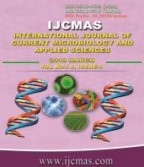


 National Academy of Agricultural Sciences (NAAS)
National Academy of Agricultural Sciences (NAAS)

|
PRINT ISSN : 2319-7692
Online ISSN : 2319-7706 Issues : 12 per year Publisher : Excellent Publishers Email : editorijcmas@gmail.com / submit@ijcmas.com Editor-in-chief: Dr.M.Prakash Index Copernicus ICV 2018: 95.39 NAAS RATING 2020: 5.38 |
Soils of Bino-river watershed in Almora district of Uttarakhand, India in north western Himalayas were characterised and classified for land categorisation and perspective land use planning. On the basis of interpretation of remote sensing data and ground truth verification three broad landforms viz., ridge tops, side slopes and valleys were identified and further sub-divided into seven landform units based on slope gradients. Nine types of soils (Pedons 1 to 9) were identified in the watershed area. Soils of valleys (Pedons 1 to 3) occur on gentle to moderates lopes and are moderately deep to very deep, well to somewhat excessively drained, sandy loam, gravelly sandy loam and loamy sand to sand in texture and slightly acidic to neutral (pH 6.11 to 6.98) in reaction. They haveA-B-C horizons in pedon 1, being classified as coarse loamy Dystric Eutrudepts and A-C horizons in pedons 2 and 3, being classified as loamy skeletal Typic Udorthents and Typic Udipsamments. They are evaluated as class III and V lands. Soils of side slopes (Pedons 4 to 7) occur on moderate to steep slopes and are shallow to moderately shallow in depth, well to excessively drained, sandy loam, gravelly sandy loam and gravelly loamy sand in texture and moderately acidic to slightly acidic (pH 5.52 to 6.49) in reaction. They have A-C horizons being classified as coarse loamy, sandy skeletal/loamy skeletal, Typic/Lithic Udorthents. They are assessed under class IV, V and VI land categories. Soils of ridge tops (Pedons 8 and 9) occur on moderately steep to steep slopes and are very shallow to shallow in depth, excessively drained, gravelly sandy loam in texture and moderately acidic (pH 5.64 to 5.95) in reaction. They have A-C and only Ahorizons and are classified as loamy skeletal Lithic Udorthents. They are evaluated as class VI and VII lands and not suitable for cultivation /plantations. The watershed area is prone to various kinds of degradation and hence proper soil and water conservation measures as well as good agronomic practices may be adopted to maintain soil health and increase productivity.
 |
 |
 |
 |
 |